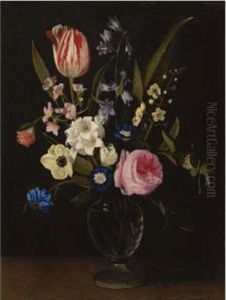Maria Theresia Van Thielen Paintings
Maria Theresia Van Thielen, born in 1640 in Mechelen, Southern Netherlands (now Belgium), was a distinguished Flemeenth-century Flemish Baroque painter, known for her exquisite still life paintings, particularly of flowers. She hailed from a family deeply entrenched in the art world; her father was the painter Jan Philips van Thielen, and she was also the niece of the famous still life painter Daniel Seghers. This familial background provided Maria Theresia with an environment rich in artistic guidance and inspiration, enabling her to hone her skills from a young age.
Maria Theresia's artistic journey was notably marked by her marriage to the painter Theodoor Rombouts, who was a prominent figure in the Flemish Caravaggisti movement, a style that was inspired by the Italian master Caravaggio. This connection further enriched her artistic environment, exposing her to a wide range of influences and styles. Despite the societal constraints placed on women in the arts during the 17th century, Maria Theresia Van Thielen managed to carve out a successful career for herself, which was a remarkable feat. Her works were highly esteemed for their delicate detail, vibrant colors, and the lifelike depiction of flowers, contributing significantly to the genre of floral still lifes.
Throughout her career, Van Thielen's paintings were sought after by collectors and art enthusiasts, including members of the nobility and the burgeoning bourgeoisie, reflecting her status as a highly respected artist of her time. Her ability to imbue her compositions with both realism and a sense of ethereal beauty set her apart from her contemporaries. Maria Theresia Van Thielen's legacy as a pioneering female artist in the Baroque period continues to be celebrated for her contributions to the still life genre and her role in paving the way for future generations of women artists. She passed away in 1706, leaving behind a body of work that continues to be admired for its artistic excellence and historical significance.
